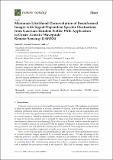Maximum Likelihood Deconvolution of Beamformed Images with Signal-Dependent Speckle Fluctuations from Gaussian Random Fields: With Application to Ocean Acoustic Waveguide Remote Sensing (OAWRS)
Author(s)
Jain, Ankita Deepak; Makris, Nicholas
Downloadremotesensing-08-00694.pdf (3.302Mb)
PUBLISHER_CC
Publisher with Creative Commons License
Creative Commons Attribution
Terms of use
Metadata
Show full item recordAbstract
Wide area acoustic remote sensing often involves the use of coherent receiver arrays to determine the spatial distribution of sources and scatterers at any instant. The resulting acoustic intensity images are typically corrupted by signal-dependent noise from Gaussian random field fluctuations arising from the central limit theorem and have a spatial resolution that depends on the incident direction, sensing array aperture and wavelength. Here, we use the maximum likelihood method to deconvolve the intensity distribution measured on a coherent line array assuming a discrete angular distribution of incident plane waves. Instantaneous wide area population density images of fish aggregations measured with Ocean Acoustic Waveguide Remote Sensing (OAWRS) are deconvolved to illustrate the effectiveness of this approach in improving angular resolution over conventional planewave beamforming.
Date issued
2016-08Department
Massachusetts Institute of Technology. Department of Mechanical EngineeringJournal
Remote Sensing
Publisher
MDPI AG
Citation
Jain, Ankita, and Nicholas Makris. “Maximum Likelihood Deconvolution of Beamformed Images with Signal-Dependent Speckle Fluctuations from Gaussian Random Fields: With Application to Ocean Acoustic Waveguide Remote Sensing (OAWRS).” Remote Sensing, vol. 8, no. 9, Aug. 2016, p. 694. © 2016 by the Authors
Version: Final published version
ISSN
2072-4292